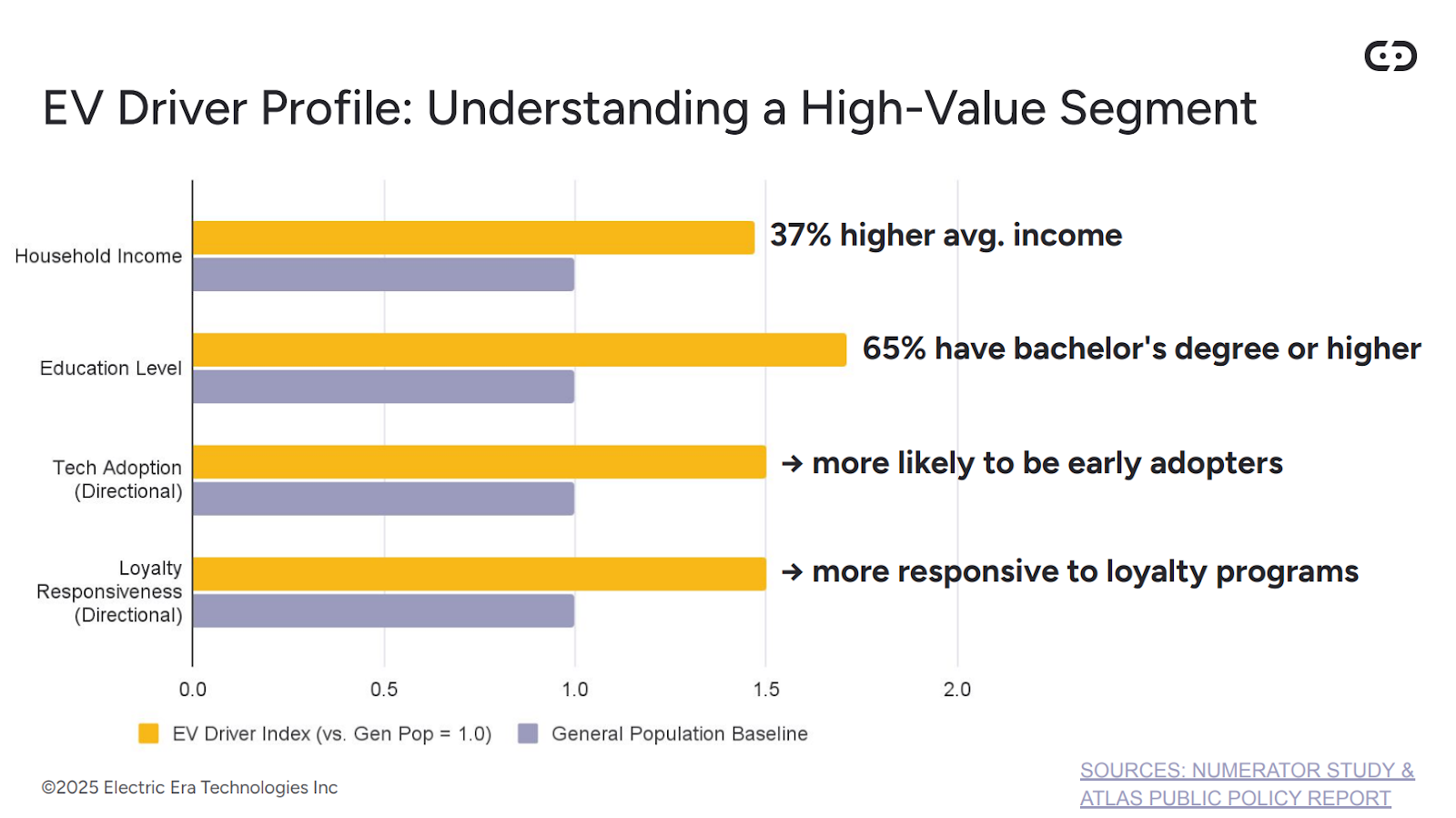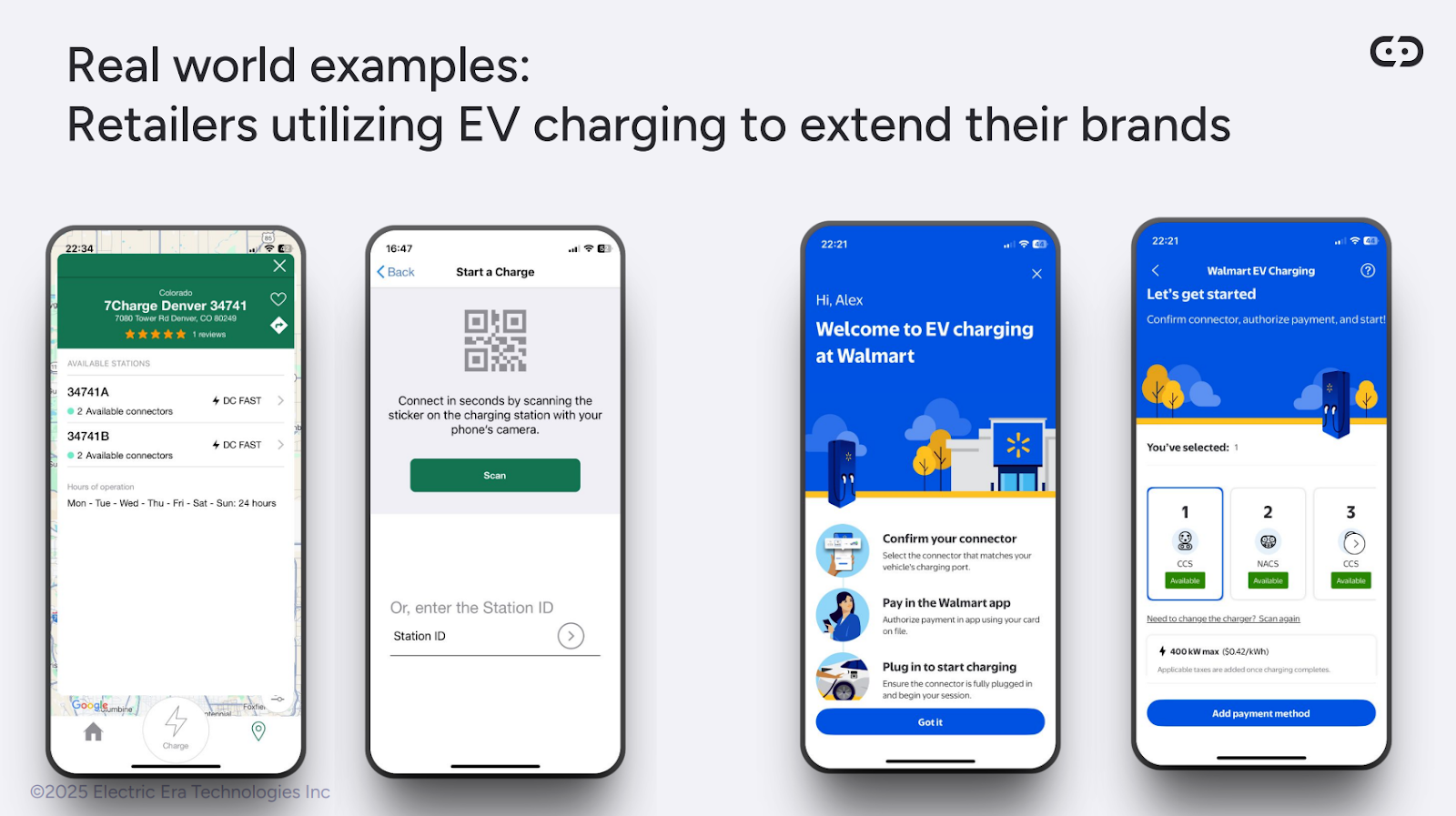The traditional fuel retail model is familiar to us all: drive, pump, grab a fountain soda inside, back on the road in under 10 minutes. Convenience stores were built with speed in mind. Small basket sizes, fewer choices, and rapid checkout keep customers moving.
This model was a lucrative playground for quick–stop operators and gas station brands, but was exclusive. When refueling only takes a few minutes, the opportunity to engage customers—especially in larger format retail—is limited. Big basket stores, pharmacies, and grocers weren’t set up to capitalize on the stop-and-go fuel model.
Now, that’s changing.
With EVs projected to make up over 50% of new U.S. car sales by 2030 (IEA, 2024), the traditional refuel model is being redefined. Longer dwell times, high-value customer demographics, and loyalty integration technologies have transformed EV charging into a strategic asset for retailers—one that’s already driving foot traffic, increasing basket sizes, and boosting customer lifetime value.
A Captive, High–Intent Audience
Unlike internal combustion engine (ICE) drivers, EV customers are incentivized to stay on-site longer. The average length of time for a paid fast charging session (Level 3) is 42 minutes (U.S. Department of Energy, 2023). That creates a window of time retailers have never had before: a captured audience with time to shop, eat, explore, and engage.
As former Starbucks loyalty executive Joy Das Gupta shared in a recent Electric Era webinar, the rise of EV charging mirrors the early adoption of public Wi–Fi in coffee shops. Initially seen as an amenity, Wi-Fi quickly became a deciding factor in where customers chose to go—not just for coffee, but for the experience it enabled. Customers didn’t just want coffee; they wanted a place to linger, work, and connect. The businesses that embraced Wi-Fi early gained their captive audience and a massive competitive edge.
EV charging is following that same path.
Just as coffee shops were once chosen based on where customers could access reliable Wi-Fi, charging locations are now being selected based on the additional value they offer. The ability to grab groceries, fill a prescription, or have lunch while charging is becoming a key driver of customer choice—with charging serving as the reason to visit, and dwell time becoming the incentive to spend.
In this way, EV charging is no longer just about delivering power, it’s about delivering value during the wait. What was once considered an ancillary perk, like being able to shop or grab a meal while your vehicle charges, is now a defining feature of the charging experience.
Retailers who recognize this shift—and design charging offerings around convenience, loyalty, and personalization—are already seeing the payoff in increased foot traffic, basket size, and customer loyalty.
More Time = Bigger Baskets
According to a report by Atlas Public Policy dwell time doesn’t just increase foot traffic, it increases basket size and purchase quality (Atlas Public Policy, 2020), especially for high-consideration items like electronics, health and wellness, cosmetics, and specialty goods. As Joy Das Gupta noted, marketers often differentiate between fast, low-consideration purchases (like coffee or a candy bar) and slower, more thoughtful ones (like eyewear or beauty products). These purchases require time—and that’s exactly what EV charging provides.
By removing time pressure, EV charging opens the door to higher–margin sales that simply don’t happen in five–minute gas station stops. Previously, only fuel retailers or convenience stores could reliably benefit from quick–turn purchases. Now, EV charging democratizes access to upwards of 45 minutes of engaged, ready-to-shop customers—giving a much broader set of retailers the opportunity to participate in the refueling economy.
The EV Customer: High–Value and Loyalty–Driven
EV drivers aren’t just a growing population, they’re a particularly valuable one. Research in the Electric Vehicle Consumer Behavior Report (Fuels Institute, 2021) shows:
- EV owners earn $45K–$65K more annually than the average U.S. household
- They favor premium retail brands and are more likely to shop while charging
- 89% make a retail purchase while charging
- And they’re 1.5x more responsive to loyalty programs than ICE drivers
These are not customers retailers can afford to ignore. And the good news is many already have the infrastructure to keep them coming back.

From Refueling to Retention: Loyalty Tools That Drive CLTV
Capturing an EV shopper is just the start. The real opportunity lies in keeping them engaged and increasing their customer lifetime value (CLTV).
This is where loyalty integration becomes a force multiplier.
Many retailers already operate successful loyalty ecosystems—and Electric Era’s platform is designed to plug into and amplify those systems. With our technology, each charging session becomes a touchpoint for engagement and retention:
- Points/Rewards for Charging: Encourage return visits and create recurring value for charging behavior.
- Tiered Charging Benefits: Offer faster or discounted charging to premium loyalty members.
- Charge Discounts with Purchase: Incentivize in–store spend to offset or eliminate charging costs.
- Personalized In-Store Offers: Serve relevant promotions based on dwell time, loyalty status, or past behaviors.
- Mobile App Integration: Create a seamless experience for shopping and charging through one platform.
The result is a bi-directional loyalty engine. Customers get tangible value from charging, and retailers gain data, foot traffic, and higher per-visit spend—all tied back to loyalty engines retailers already possess.

Reliability Is Loyalty Infrastructure
Of course, even the best loyalty strategy fails without a reliable charging experience. In an ecosystem plagued by failed sessions, broken chargers, and app friction, customers quickly lose patience.
That’s why Electric Era built charging for performance from the ground up.
- 98%+ per port uptime guarantee
- 92%+ session reliability
- 99%+ of issues resolved without on-site support
Our infrastructure is powered by remote diagnostics, autonomous error detection, 24/7 monitoring, and includes tap-to-pay, app-free sessions, and compatibility with all major payment methods.
Why does that matter? Because friction kills loyalty. A seamless, dependable charging experience makes it easier to engage customers with promotions, rewards, and branded moments they’ll respond to again and again.
Who’s Already Winning
Retailers across the country are already acting on this opportunity. The ones seeing the greatest impact share a few key traits:
- They own or control their real estate (grocery, big–box, club stores, pharmacies)
- They operate in high–margin or high–frequency categories (beauty, wellness, electronics)
- They’ve invested in loyalty and digital marketing ecosystems
- They’re located in EV-forward states like California, Washington, or New York
These brands are not just future–proofing, they’re growing CLTV today by turning charging sessions into commerce sessions.
The New Retail Advantage is Already Here
The retailers capturing value from EV charging aren’t waiting for infrastructure mandates or national networks to mature. They’re already integrating charging into how they attract, serve, and retain customers.
In the coming years, EV charging won’t be a differentiator, it will be a baseline expectation, just like Wi-Fi or mobile ordering. The time to build loyalty and drive foot traffic is now. The retailers who move early are positioned to own the next generation of refueling behavior.